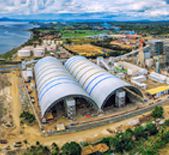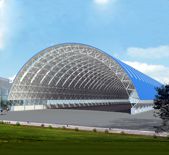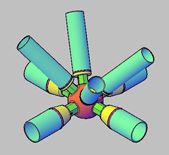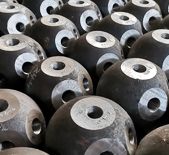In the field of construction and industrial facilities, space frame structure is favored for its unique spatial shape and good mechanical properties. The application of windbreaks in space frame structure adds new functions and values to this structural form.
1.Application Scenarios and Methods
Industrial Building
In the roof and wall of industrial factory space frame structure, windbreaks play a vital role. For plants that store raw materials susceptible to airflow (such as powdered and granular materials) or carry out high-precision processing operations, windbreaks can be installed on the façade of the space frame structure to form a barrier. They can effectively block strong winds from entering the interior of the plant, avoiding the dispersion of raw materials and damage to the precision of the processing equipment. For example, in the raw material warehouse of the grid structure of a cement factory, the installation of windbreaks can significantly reduce the wind dispersion of powdery cement raw materials, ensuring the effective storage of raw materials and the smooth running of the subsequent production process. In terms of installation, the windbreaks can be fixed to the bars of the grid structure by means of special fixtures or connectors. This type of connection not only ensures the stability of the windbreaks, but also does not have a negative impact on the mechanical properties of the grid structure itself. Moreover, according to the wind direction and wind force characteristics of different locations in the plant, the angle and density of the windbreaks can be flexibly adjusted to achieve the best windbreak effect.

Sports Building
In sports stadiums and other large-scale space structure buildings, the application of windbreaks is also becoming more and more widespread. For example, installing windbreaks on the perimeter fence of an open-air tennis court or soccer stadium can create a relatively comfortable environment for athletes and spectators. In the course of the game, strong winds may affect the flight trajectory of balls such as tennis and soccer, interfering with the athletes’ play, and at the same time making the spectators feel uncomfortable. By setting windbreaks on the space frame structure, the wind speed can be effectively reduced so that the game can be played in a more favorable environment. In addition, the space frame structure roof of the stadium can also utilize windbreaks to improve the ventilation environment inside. In some stadiums with open and close roofs, when the roof is partially open, the windbreaks installed on the edges of the openings can guide the direction of the airflow, prevent the formation of turbulence, and improve the quality of air circulation in the stadium.
2.Performance Improvement
Enhanced Structural Stability
When the windbreak is installed on the grid structure, it changes the wind load distribution around the structure to a certain extent. Through reasonable design, the windbreak can decompose and divert the strong wind that originally acts directly on the space frame structure, and reduce the wind pressure and suction force borne by the structure. This is crucial to improve the stability of the grid structure in strong winds, especially for those large-span, lightweight grid structure buildings, which can effectively reduce the risk of structural vibration, deformation or even damage. For example, in a large-scale space frame structure exhibition hall in the coastal area, before installing the windbreaks, the strong wind may cause the nodes of the space frame structure to produce large displacements and stress concentrations. After the installation of windbreaks, wind tunnel tests and actual monitoring found that the displacement of the structure was significantly reduced, the stress distribution was more uniform, and the overall stability was significantly improved.

Energy Efficiency Improvement
In some grid structure buildings with air conditioning or ventilation systems, the application of windbreaks helps to improve energy efficiency. By blocking the excessive entry of cold or hot outdoor air into the interior, the heat exchange between the indoor and outdoor environments is reduced, thus reducing the load on the air conditioning or ventilation equipment. This not only saves energy consumption, but also extends the service life of the equipment. Taking a large shopping mall with a space frame structure as an example, in winter, the wind-blocking panels installed at the entrance and around the roof vents can effectively prevent the intrusion of cold air, so that the heating system inside the shopping mall can maintain a comfortable temperature more efficiently and reduce the waste of energy.
3.The Integration of Aesthetics and Function
The application of windbreaks in the grid structure is not only the embodiment of functionality, but also brings new elements to architectural aesthetics. Nowadays, windbreaks are available in a variety of materials and colors, which can be selected according to the overall style and design concept of the building. They can mirror the lines of the grid structure and form a unique visual effect. For example, transparent or semi-transparent polycarbonate windbreaks are used in some modern airport terminal space frame structure buildings, and these windbreaks can allow natural light to softly penetrate into the room while blocking airflow, creating a bright and airy spatial atmosphere. Moreover, the shape of the windshield can be customized according to the shape of the building, such as the use of curved or wavy design, so that the building has the function of wind protection at the same time, more artistic infectious force. The application of windbreaks in space frame structure is a combination of multi-functionality and high efficiency. It not only improves the practicality and comfort of the space frame structure building, but also brings many positive effects on the appearance design and energy utilization efficiency of the building, which is a model of the combination of modern building technology and functional requirements.











 About Us
About Us 2025-03-26
2025-03-26


